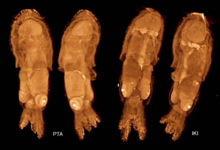| Idiosepius pygmaeus | |
|---|---|

| |
| Hatchlings of Idiosepius pygmaeus (ca. 2 mm long) stained with phosphotungstic acid (left) and Lugol's iodine (right) | |

| |
| Tropical Pigmy squid | |
| Conservation status | |
 Data Deficient (IUCN 3.1) | |
| Scientific classification | |
| Domain: | Eukaryota |
| Kingdom: | Animalia |
| Phylum: | Mollusca |
| Class: | Cephalopoda |
| Order: | Idiosepida |
| Family: | Idiosepiidae |
| Genus: | Idiosepius |
| Species: | I. pygmaeus |
| Binomial name | |
| Idiosepius pygmaeus Steenstrup, 1881 | |
Idiosepius pygmaeus, also known as the two-toned pygmy squid or tropical pygmy squid, is a species of bobtail squid native to the Indo-Pacific. It occurs in waters of the South China Sea, Japan, Philippines, Palau, Indonesia, Northern Mariana Islands, as well as northern and northeastern Australia. It inhabits shallow, inshore waters.
I. pygmaeus weighs 0.00033 g upon hatching and increases in weight to 0.175 g as it reaches maturity in 50 days (1260 degree days). It inhabits waters at a temperature of 25.2 °C. Growth rate has been calculated as 12.55 and physiological growth rate as 0.498.
I. pygmaeus grows to 20 mm in mantle length.
This species has been reared on a diet of glass shrimp (Acetes sibogae australis) in the laboratory.
The type specimen was collected in the South China Sea (04°20′N 107°20′E / 4.333°N 107.333°E / 4.333; 107.333) and is deposited at the Zoologisk Museum of Kobenhavns Universitet in Copenhagen.
The Idiosepius pygmaeus is heavily concentrated in seagrass meadows. They are known to attach onto seagrass using a special organ that supports adhesion. However, due to environmental changes caused by human activities, seagrass meadows have been disturbed. This habitat used for shelter by organisms such as the Idiosepius are being threatened.
References
- Barratt, I.; Allcock, L. (2012). "Idiosepius pygmaeus". IUCN Red List of Threatened Species. 2012: e.T162604A926579. doi:10.2305/IUCN.UK.2012-1.RLTS.T162604A926579.en. Retrieved 19 November 2021.
- "WoRMS - World Register of Marine Species - Idiosepius pygmaeus Steenstrup, 1881". www.marinespecies.org. Retrieved 2022-02-25.
- ^ Reid, A. 2005. Family Idiosepiidae. In: P. Jereb & C.F.E. Roper, eds. Cephalopods of the world. An annotated and illustrated catalogue of species known to date. Volume 1. Chambered nautiluses and sepioids (Nautilidae, Sepiidae, Sepiolidae, Sepiadariidae, Idiosepiidae and Spirulidae). FAO Species Catalogue for Fishery Purposes. No. 4, Vol. 1. Rome, FAO. pp. 208–210.
- "Countries' Exclusive Economic Zones with Idiosepius pygmaeus". Archived from the original on 2003-05-23. Retrieved 2007-02-26.
- Wood, J.B. & R.K. O'Dor 2000. "Do larger cephalopods live longer? Effects of temperature and phylogeny on interspecific comparisons of age and size at maturity" (PDF). Archived from the original (PDF) on 2004-12-14. (134 KiB) Marine Biology 136(1): 91–99.
- Jackson, G.D. 1988. The Use of Statolith Microstructures to Analyze Life-history Events in the Small Tropical Cephalopod Idiosepius pygmaeus. Fishery Bulletin (U.S.) 87: 265-272.
- Current Classification of Recent Cephalopoda
Further reading
- Jackson, G.D. 1989. The use of statolith microstructures to analyze life-history events in the small tropical cephalopod Idiosepius pygmaeus. Fishery Bulletin 87: 265-272.
- Jackson, G.D. 1992. Seasonal variation in reproductive investment in the tropical Loliginid squid Loligo chinensis and the small tropical Sepioid Idiosepius pygmaeus. Fishery Bulletin 91: 260-270.
- Jackson, G.D. 1992. Seasonal abundance of the small tropical Sepioid Idiosepius pygmaeus (Cephalopoda: Idiosepiidae) at two localities off Townsville, north Queensland Australia. The Veliger 35(4): 396-401.
- Jenkins, T., Strugnell, J. M., & Spady, B. L. (2024). The habitat preferences of Idiosepius pygmaeus and their use of conspecific cues. Marine Ecology. https://doi.org/10.1111/maec.12786
- Moynihan, M. 1983. Notes on the behavior of Idiosepius pygmaeus (Cephalopoda; Idiosepiidae). Behaviour 85: 42-57.
- Sasaki, M. 1923. On an adhering habit of a pygmy cuttlefish, Idiosepius pygmaeus Steenstrup. Annotationes Zoolodicae Japanenses 10(21): 209-213.
External links
- "CephBase: Idiosepius pygmaeus". Archived from the original on 2005-08-17.
- Latitude and Longitude Data for Idiosepius pygmaeus
- GenBank Links for Genetic Information on Idiosepius pygmaeus
- Photos of Idiosepius pygmaeus on Sealife Collection
| Taxon identifiers | |
|---|---|
| Idiosepius pygmaeus | |
This article related to bobtail squids is a stub. You can help Misplaced Pages by expanding it. |